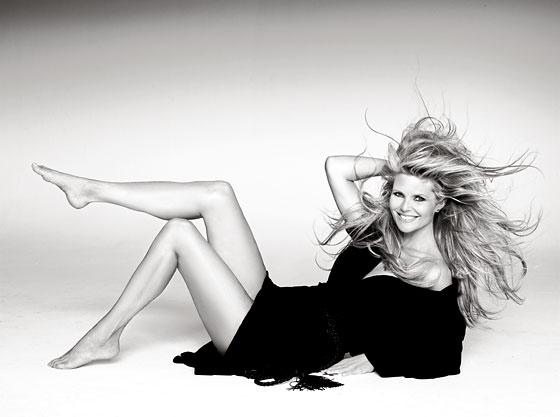 |
Long wrap dress, $7,000, and braided belt, $840, at Hermès, 691 Madison Ave., at 62nd St. (212-751-3181). Emerald-cut diamond and platinum stud earrings, $65,000 at Tiffany & Co., 727 Fifth Ave., nr. 56th St. (212-755-8000).
Hair by Italo Gregorio for Bryan Bantry. Makeup by Leslie Lopez for ArtistsbyTimothyPriano.com. Manicure by Elisa Ferri at See Management. Styling by Harriet Mays Powell. Fashion assistants: Doria Santlofer and Eve Bertin-Lang.
(Photo: Ruven Afanador) |
Much has been made of the light in the Hamptons: It is perfect for painting, it is perfect for sunning, it is perfect for illuminating the shingled houses, the electric-green lawns, the hedges and the pools and the soft clay courts.
It is also perfect, on this Saturday afternoon in August, for regarding Christie Brinkley. Her hair is thick and golden, her skin is tanned but only just. Her teeth are gleaming, her waist is narrow, and she’s dressed like the popular girl from your high school: tight red tank top, tight dark jeans, groovy purple sneakers laced up in some complicated unlaced way, and sporty Oakley shades. One wrist is wrapped with an uncomfortable-looking amount of beads and baubles and charms and two leather bands in Rasta colors that demand, STOP GLOBAL WARMING NOW!
She’s a month past her very public, very ugly court divorce from her equally tanned, equally gleaming ex-husband, the architect Peter Cook, but Brinkley shows no strain. She looks like she slept really well last night, and every night for her entire life, and as if she’s fortified herself with only the most local, organic, and expensive of foods since before she was born. It’s as if she’s absorbed the well-organized beauty of her surroundings through her pores, as if she’s a natural extension of the blue sky and its fluffy clouds.
“Can you believe this place?” Brinkley is saying, as she wanders the yard of the boxy Colonial whose lawn ends on the quiet, sandy edge of Sag Harbor. Across the water are the rooftops of the village, a village she is hell-bent on preserving from condos and chain pharmacies. She bought this house last year for almost $10 million, with the intention of putting up her parents, but the stairs proved difficult for them, so she plans to move them to yet another of her houses—one in town—and decided that this house, with its streaming light and views and wide plank floors, should be her office. She’s filled it with framed portraits from her modeling years: a platinum copy of “Uptown Girl,” herself on the cover of Redbook, and so on. She’s got plans: an organic farm outside and a “homework club” upstairs.
“Isn’t it wonderful?” Brinkley says, throwing her arms wide. She speaks in the breathy, enthusiastic delivery of a librarian reading aloud to someone in the third grade, and she smiles almost constantly. She can talk through the smile—which reveals both top and bottom teeth at all times—almost like a ventriloquist.
“Woooow,” she exclaims, “look at the sky. Isn’t it painterly? Look at the brushstrokes. Wow. Isn’t it cool?”
Across the street from this (by Hamptons standards) modest house is a big white colonnaded Greek Revival Tara that Brinkley bought in 2003 but has yet to inhabit. She’s planning to make it her full-time home as soon as she unloads Tower Hill, the 20-acre Bridgehampton estate she has listed for $30 million. Tower Hill has a frog pond, a skateboard park, a campsite, a snowboard hill, and a path on which she and the other mothers from the Ross School like to cross-country ski. But she’s done with that life. “I just want to be here,” she says, sighing. “I mean, look at this. I just want to be here.”
A curious choice, considering that big white house factored quite prominently into the divorce: It was where Cook liked to bring his teenage girlfriend, the one he hired away from her job at a toy shop with one thing in mind. During the trial, it was stated that Brinkley once dropped by that house to find a long, dark hair on a rumpled bed.
Brinkley is wearing a pair of diamanté peace signs in her ears. The buckle of the belt that’s slung mid-hip across her tight, dark jeans is a peace sign, and the water glasses from which she sips chilled bubbly water have peace signs on them, too, as well as a slogan: back by popular demand.
“Look at the coastline!” Brinkley says, with feeling. “I just love America. I love living here.”
Brinkley’s all-American face was discovered in an unusual setting. In 1973, Brinkley, just 18, had moved to Paris to study art, and she had already married an arty Frenchman, an illustrator named Jean-François. Her beloved dog Bianca was sick, and she was carrying the dog in a basket on her way to a phone to call a vet when an American photographer spotted this bit of California walking down the street and demanded she stop by the offices of the top modeling agencies. Reluctantly, she agreed. “You have to understand,” Brinkley says, settling into an iron chair on the edge of her property, just feet from the lapping shore, “that I came to France to be so bohemian. It was all”—and here Brinkley does an elaborate Pepé Le Pew accent—“How can you mo-dell. Is so bourgeois.” She also says she sort of couldn’t believe it. “I was basically a surfer girl from California. I never looked like a model. Models were thin, and they were very sophisticated, and their poses were kind of like—” Brinkley leaps out of her chair and throws her nose up into the air. “Hoity,” she says, and sits down. Brinkley was then, as she is now, athletic and strong and approachable.

